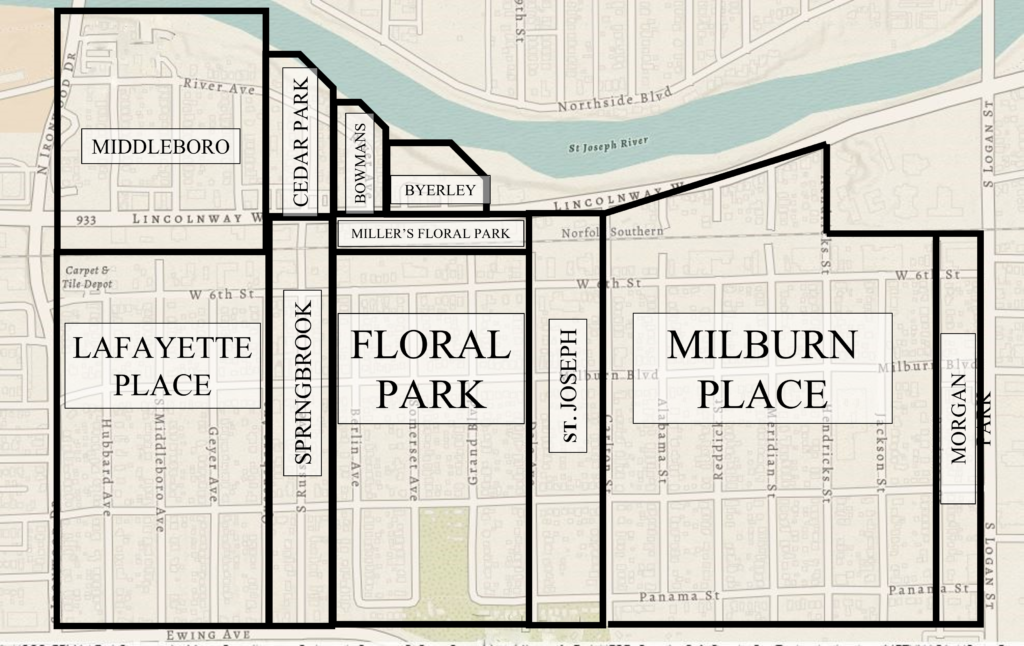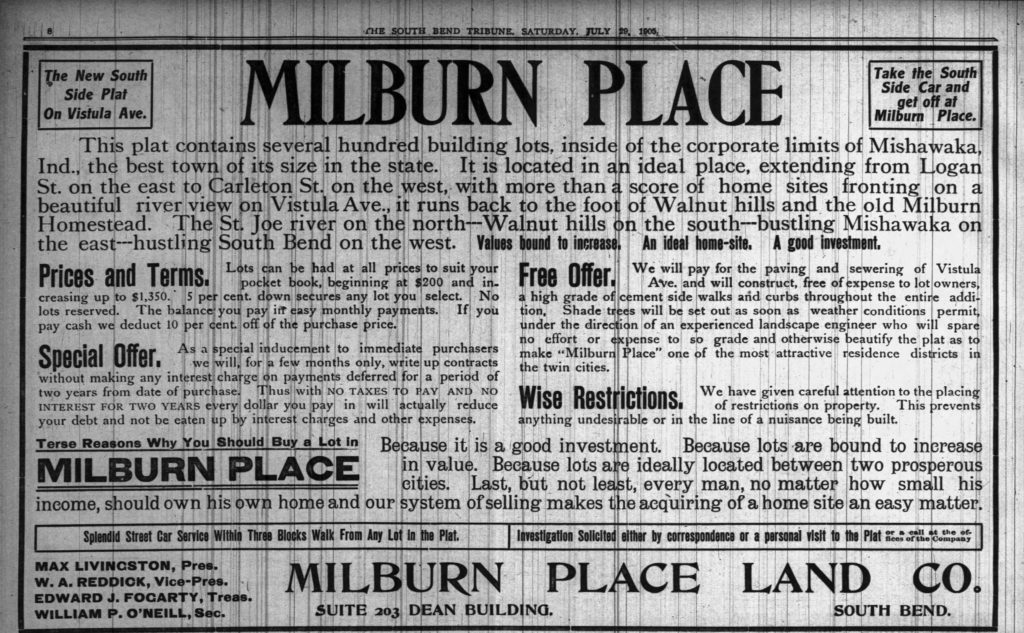Growth of a city: 1830s - 1920s
To fully appreciate the tale of Hooligan Heights, it is essential to understand its historical context as part of a broader, thriving community. While the neighborhood was not platted until 70 years after the first white settlers arrived in the area, its genesis was necessitated by decades of economic growth. The expansion of industry in Mishawaka in the late 1800s created employment opportunities that enticed immigrants from Europe and the eastern United States. As the population grew rapidly, land was needed for new residents who were eager for work and a place to reside.
The first white settlers arrived in Mishawaka to mine bog iron deposits in the early 1830s. Within a few years, several hundred people had moved into the vicinity. The iron business prospered, and in 1838, Mishawaka was incorporated as a town along the banks of the St. Joseph River. By 1851, the first rail line was extended through the city, and from there the fate of the town was sealed.
Mishawaka’s industry grew extensively, and by the turn of the century, it would become one of the leading manufacturing centers of the Midwest. St. Joseph Iron Works eventually became St. Joseph Manufacturing Company, and a myriad of other successful businesses arrived on the scene: Perkins Windmill Company, Mishawaka Rubber and Woolen Company (Ball-Band), Dodge Manufacturing Company, and many others, as well as the shops and enterprises that served the dutiful employees.

As commercial and industrial activity continued to increase in the early part of the twentieth century, Mishawaka experienced enormous growth. In the decade following the turn of the century, the city doubled in population and land area. In the 1920s, the population soared again. Between 1900 and 1930, the number of residents in the city grew more than fivefold, from 5,500 to almost 29,000. This growth necessitated new development and expansion to accommodate the growing populace that would serve Mishawaka’s thriving industrial base.
While much of Mishawaka’s population surge was due to immigration and births, not all of its growth was organic. In the early twentieth century, Mishawaka expanded its footprint dramatically. In 1904, the city moved to annex territory that would double its size: the largest annexation in Mishawaka history. The city planned to incorporate almost 1,400 acres of land on all sides, with the exception of the northwest. Some of the local farmers and landowners were opposed to this, and they legally challenged the city in a case that would eventually find its way to the Indiana Supreme Court. However, after battling for three years and ironing out compromises, the city triumphed. The boundaries for annexation were solidified by 1908. This additional territory included land that would eventually house iconic parts of Mishawaka: the West End, Merrifield Park, Mishawaka High School, Fairview Cemetery, and of course, the infamous Hooligan Heights. At this stage, land finally connected the two thriving communities of Mishawaka and South Bend: the cities were now one contiguous urban area.
The location of this latest annexation on the far west side of Mishawaka put the neighborhood in a prime position: close and equidistant to the downtowns of the two burgeoning cities. Hooligan Heights was comprised of several land additions, three of which dominated the landscape: Milburn Place, Floral Park, and Lafayette Place. After the area became officially part of Mishawaka, developers purchased the property from local farmers and other landowners. They were optimistic for generating substantial profits, as Mishawaka and South Bend were growing rapidly, and housing was in short supply.
The first large plat addition was Milburn Place, in what is now the east end of Hooligan Heights. In 1905, the year after Mishawaka announced it would annex new land, the Milburn Place Land Company was organized to acquire and sell property. It purchased the farm of Henry C. Morgan, which was located on the land between Burdette Street and Carlton Street, south of Second Street (Lincolnway) and extending to where Panama Street is today. While most of the land on the west side of Hooligan Heights was not developed until after the First World War (1914-1918), the first advertisements for lot sales of Milburn Place appear in 1906. Advertisements in the South Bend Tribune touted, “More liberal land contracts were never written than are being given to the buyers of the first 150 lots in this attractive plat…These lots are being sold for what they are worth now, not what they will be worth when the two new interurban roads have crossed the property.” In the summer of 1906, the Milburn Land Company developers even staged a gimmick to entice interested parties: sending up a balloon with a tag that entitled the finder to a free lot in Milburn Place.
By 1914, growth in the area warranted mail delivery, and Mishawaka extended postal service to the northern end of this newly annexed area. A mounted carrier would travel down Lincolnway between Logan Street and Ernsberger Street (Ironwood Drive) to deliver mail to homes and businesses that fronted Lincolnway. If residents who did not front Lincolnway desired mail delivery, they either had to go to the post office or erect a private mailbox along Lincolnway. Occupants south of the New York Central Railroad tracks had to navigate the dangerous crossing two times a day to obtain their mail. (This was the way mail was delivered in the area until door-to-door service became available in 1927.) Milburn Place was quickly developed, and the oldest homes in Hooligan Heights are located there, with many constructed before 1910.
The next large plat addition was Floral Park, between Dale and Berlin Avenues. It was subdivided soon after Milburn Place, but it was not developed until after World War I. Lafayette Place, the final addition, was located between Queensboro and Ironwood, and it is the most western part of Mishawaka. It was the last part of the entire west side to be annexed into the city, well after World War I had ended. Several other smaller additions, such as Springbrook, Saint Joseph Park, Morgan Park, and Middleboro sat on smaller plats of land between the largest three additions. While all of these additions constituted the area known as Hooligan Heights today, the Floral Park Addition was the most well-known at the time. That tract would be the one that lent its name to the community. Residents, the city, and formal publications began referencing the entire area as “Floral Park.” This was the land between Logan Street, Ernsberger Street, Lincolnway West, and Ewing Avenue.

